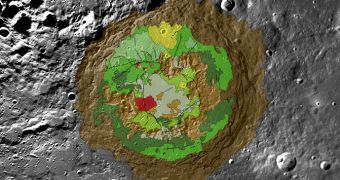Researchers have recently developed an impressive geological map of the Schrödinger Basin on the surface of the Moon, one of the most renowned features our natural satellite has.
Now, the landscape feature features a new, camouflage-colored appearance, which allows geologists to make more sense of the changes that went on inside over millions of years.
The Moon has been subjected to incredibly rough asteroid and meteor bombardments in its earlier day, and most of the lunar surface still exhibits scars that tell the tale
In strict geological terms, the Basin is still fairly young, if such a term can be applied to a structure that is around 3.8 billion years old, Space Fellowship reports.
According to official statistics, it is the second-youngest large basin on the surface of the satellite, boasting a diameter of 200 miles, or 320 kilometers.
What makes this particular site interesting is the fact that it exists close to the lunar south pole, which is an area that contains frozen water-ice deep inside craters.
This was evidenced at the end of last years, as the LCROSS impactor followed a spent Centaurus rocket stage in slamming into a crater at the Moon's south pole.
The resulting debris plume was analyzed thoroughly using spectrograph technology, and the data seemed to indicate that vast amounts of water ice existed at the location.
Because of this, the Moon has again regained its importance as a major objective in space exploration, and robots such as the Lunar Reconnaissance Orbiter (LRO) are currently searching for sites where prospective manned missions could land.
If a permanent base is to be established on the satellite, then astronauts would need access to water-ice for producing oxygen, rocket fuel, and also water.
As such, they would need to land next to one of the craters containing water-ice, and the new geological map of the Schrödinger Basin is aimed at making this easier.
Additionally, this particular crater is also very interesting because it features lava flows and other similar structures, which are clear indicators that volcanic activity took place here recently.
The LRO will continue mapping the lunar surface. The surface data it collects is usually combined with other databases, collected by spacecrafts that came before it.

 14 DAY TRIAL //
14 DAY TRIAL //